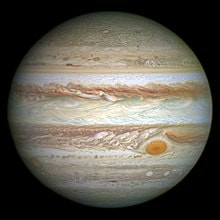 This piece was originally broadcast on Radio Scilly in April 2019. During April, Jupiter, the largest planet in our solar system, is increasing in brightness and visibility. It’s been absent from our skies for months, along with lovely ringed planet Saturn. At the moment, Jupiter’s a dominant object in the wee hours of the morning, albeit one that doesn’t get very high in the sky. However on Scilly, our long and low horizons give us a good chance of seeing. By the end of the month Jupiter will be rising in the sky from midnight. However for now, you’ll have to be up just before dawn to catch a good glimpse of this bright gas giant. Currently, the planet reaches its peak height (also known as its culmination) somewhere around 4am. Is it worth getting out of bed for? If – like me – you’ve missed this gem of a planet then of course the answer is yes. And the bonus is that at the moment it’s best viewed with binoculars or a small telescope. However the truth is that Jupiter will be visible far better as summer gets into swing and it rises in the sky. Rather earlier at that. By July, it’ll be visible at dusk! Jupiter is the 4th brightest object in the night sky, after the Moon, Venus and then Mars. Jupiter is known as the largest planet in the solar system, and by quite some stretch. Jupiter’s mass is 318 times that of the Earth, and in fact Jupiter is 2.5 times more massive than all of the other planets in the solar system combined! It’s a gas giant, mostly composed of Hydrogen with some Helium, though it likely has a rocky core. To look at, it’s stripey – as it has a distinctive system of bands of clouds, made from ammonia crystals, looping round its middle. With binoculars, you’ll be able to see Jupiter as a flat disc, this shape caused by its incredibly fast spin rate for such a whopping object – a day on Jupiter is just 10 hours short. With a small telescope, you’ll be able to pick our Jupiter’s distinctive clouds and possibly – depending on timing and visibility which always requires a bit of luck – the great red spot. This is a giant tornado-like storm that’s been raging on Jupiter for at least 350 years. With winds at an estimated 270mph, it really is blowing a hoolie. Jupiter can be found, low in the sky, early in the morning, by looking to the South!
0 Comments
Your comment will be posted after it is approved.
Leave a Reply. |
BYCharlie Payne POSTS
September 2024
|

 RSS Feed
RSS Feed